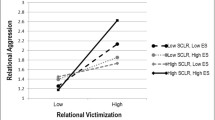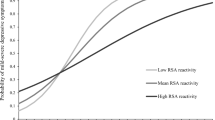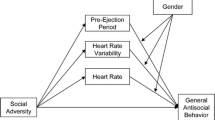Abstract
This study tested biological sensitivity to context theory in the peer context. Respiratory sinus arrythmia (RSA-R) and skin conductance level (SCL-R) reactivity to a peer stressor were collected for participants (N = 86; M age = 45.99 months old; 70.2% White) in the summer (Time 1). Children’s peer risk (i.e., physical and relational victimization) and protective (i.e., received prosocial behavior) factors were examined in the fall (T2) and relational and physical aggression were measured at T2 and in the spring (T3). Interactions were tested in regression analyses. Interactions emerged between relational victimization, RSA-R, and SCL-R in the prediction of T3 relational aggression and between received prosocial behavior, RSA-R, and SCL-R in the prediction of T3 relational and physical aggression, respectively. There was a positive relation between T2 relational victimization and T3 relational aggression for children with a coactivation pattern (i.e., increased RSA and SCL activity to a bullying stressor) but no relation for any other physiological pattern. Conversely, there was a negative relation between T2 received prosocial behavior and both forms of aggression at T3 for children with a reciprocal pattern (i.e., increased RSA and decreased SCL or decreased RSA and increased SCL activity) but no protective benefit of received prosocial behavior on subsequent aggression for children with a coactivation pattern. For children with a coinhibition pattern (i.e., decreased RSA and SCL activity), received prosocial behavior was negatively related to subsequent physical but not relational aggression. In sum, a coactivation pattern in response to stress may represent a vulnerability factor.


Similar content being viewed by others
Data Availability
Data is available by contacting the authors.
Notes
The base and final interaction models were also run controlling for nesting within school. These analyses are included in the supplemental materials and mirrored the results in the main text, with the exception of the main effect of SCL-R on physical aggression at T3, which was no longer significant.
References
Abaied, J. L., Stanger, S. B., Wagner, C., Sanders, W., Dyer, W. J., & Padilla-Walker, L. (2018). Parasympathetic and sympathetic reactivity moderate maternal contributions to emotional adjustment in adolescence. Developmental Psychology, 54(9), 1661–1673. https://doi.org/10.1037/dev0000507
Baraldi, A. N., & Enders, C. K. (2010). An introduction to modern missing data analyses. Journal of School Psychology, 48, 5–37. https://doi.org/10.1016/j.jsp.2009.10.001
Beauchaine, T. P., Bell, Z., Knapton, E., McDonough‐Caplan, H., Shader, T., & Zisner, A. (2019). Respiratory sinus arrhythmia reactivity across empirically based structural dimensions of psychopathology: A meta‐analysis. Psychophysiology, 56(5), e13329–n/a. https://doi.org/10.1111/psyp.13329
Beauchaine, T. P., Gatzke-Kopp, L., & Mead, H. K. (2007). Polyvagal Theory and developmental psychopathology: Emotion dysregulation and conduct problems from preschool to adolescence. Biological Psychology, 74(2), 174–184. https://doi.org/10.1016/j.biopsycho.2005.08.008
Benito-Gomez, M., Fletcher, A. C., & Buehler, C. (2018). Sympathetic and Parasympathetic Nervous System Functioning and Experiences of Peer Exclusion: Links to Internalizing Problems in Early Adolescence. Journal of Abnormal Child Psychology, 47(4), 633–644. https://doi.org/10.1007/s10802-018-0472-0
Berntson, G., Quigley, K., Norman, G., & Lozano, D. (2017). Cardiovascular psychophysiology. In J. Cacioppo, L. Tassinary, & G. Berntson (Eds.), Handbook of psychophysiology (Cambridge Handbooks in Psychology, pp. 183–216). Cambridge University Press. https://doi.org/10.1017/9781107415782.009
Boyce, W. T., & Ellis, B. J. (2005). Biological sensitivity to context: I. An evolutionary developmental theory of the origins and functions of stress reactivity. Development and Psychopathology, 17(2), 271–301. https://doi.org/10.1017/s0954579405050145
Brain-Body Center, University of Illinois at Chicago. (2007). Cardio Batch Software. [Computer Software].
Browne, M. W., & Cudeck, R. (1992). Alternative ways of assessing model fit. Sociological Methods & Research, 21(2), 230–258. https://doi.org/10.1177/0049124192021002005
Buss, K. A., Jaffee, S., Wadsworth, M. E., & Kliewer, W. (2018). Impact of psychophysiological stress-response systems on psychological development: Moving beyond the single biomarker approach. Developmental Psychology, 54(9), 1601–1605. https://doi.org/10.1037/dev0000596
Calkins, S. D., & Keane, S. P. (2004). Cardiac vagal regulation across the preschool period: Stability, continuity, and implications for childhood adjustment. Developmental Psychobiology, 45(6), 101–112. https://doi.org/10.1002/dev/20020
Crick, N. R., Casas, J. F., & Ku, H.-C. (1999). Relational and physical forms of peer victimization in preschool. Developmental Psychology, 35(2), 376–385. https://doi.org/10.1037/0012-1649.35.2.376
Crick, N. R., Casas, J. F., & Mosher, M. (1997). Relational and overt aggression in preschool. Developmental Psychology, 33(4), 579–588. https://doi.org/10.1037/0012-1649.33.4.579
Crick, N. R., Ostrov, J. M., Burr, J. E., Cullerton-Sen, C., Jansen-Yeh, E., & Ralston, P. (2006). A longitudinal study of relational and physical aggression in preschool. Journal of Applied Developmental Psychology, 27(3), 254–268. https://doi.org/10.1016/j.appdev.2006.02.006
Darling-Churchill, K. E., & Lippman, L. (2016). Early childhood social and emotional development: Advancing the field of measurement. Journal of Applied Developmental Psychology, 45, 1–7. https://doi.org/10.1016/j.appdev.2016.02.002
Dawson, M., Schell, A., & Filion, D. (2016). The electrodermal system. In J. Cacioppo, L. Tassinary, & G. Berntson (Eds.), Handbook of psychophysiology (Cambridge Handbooks in Psychology, pp. 217–243). Cambridge University Press. https://doi.org/10.1017/9781107415782.010
Dieleman, G. C., Huizink, A. C., Tulen, J. H., Utens, E. M., & Tiemeier, H. (2016). Stress reactivity predicts symptom improvement in children with anxiety disorders. Journal of Affective Disorders, 196, 190–199. https://doi.org/10.1016/j.jad.2016.02.022
Early Child Care Research Network (ECCRN). (2004). Trajectories of physical aggression from toddlerhood to middle childhood. Monographs of the Society for Research in Child Development, 69(4), 102–119. https://doi.org/10.1111/j.0037-976X.2004.00318.x
Eisenberg, N., Eggum-Wilkens, N. D., & Spinrad, T. L. (2015). The development of prosocial behavior. In D. A. Schroeder & W. G. Graziano (Eds.), The oxford handbook of prosocial behavior (pp. 114–136). Oxford University Press.
Ellis, B. J., Boyce, W. T., Belsky, J., Bakermans-Kranenburg, M. J., & Van Ijzendoorn, M. H. (2011). Differential susceptibility to the environment: An evolutionary neurodevelopmental theory. Development and Psychopathology, 23, 7–28. https://doi.org/10.1017/S0954579410000611
El-Sheikh, M., & Erath, S. A. (2011). Family conflict, autonomic nervous system functioning, and child adaptation: State of the science and future directions. Development and Psychopathology, 23(2), 703–721. https://doi.org/10.1017/S0954579411000034
El-Sheikh, M., Keiley, M., Erath, S., & Dyer, W. J. (2013). Marital conflict and growth in children’s internalizing symptoms: The role of autonomic nervous system activity. Developmental Psychology, 49(1), 92. https://doi.org/10.1037/a0027703
El-Sheikh, M., Kouros, C. D., Erath, S., Cummings, E. M., Keller, P., Staton, L., & Moore, G. A. (2009). Marital conflict and children’s externalizing behavior: Interactions between parasympathetic and sympathetic nervous system activity. Monographs of the Society for Research in Child Development, 74(1), 1–69. https://doi.org/10.1111/j.15405834.2009.00502
Erath, S. A., El-Sheikh, M., Hinnant, J. B., & Cummings, E. M. (2011). Skin conductance level reactivity moderates the association between harsh parenting and growth in child externalizing behavior. Developmental Psychology, 47(3), 693 706. https://doi.org/10.1037/a0021909
Fabes, R. A., Hanish, L. D., Martin, C. L., Moss, A., & Reesing, A. (2012). The effects of young children’s affiliations with prosocial peers on subsequent emotionality in peer interactions. British Journal of Developmental Psychology, 30(4), 569–585. https://doi.org/10.1111/j.2044835X.2011.02073
Farrell, A. D., Sullivan, T. N., Goncy, E. A., & Le, A.-T.H. (2016). Assessment of adolescents’ victimization, aggression, and problem behaviors: Evaluation of the Problem Behavior Frequency Scale. Psychological Assessment, 28(6), 702–714. https://doi.org/10.1037/pas0000225
Godleski, S. A., Kamper, K. E., Ostrov, J. M., Hart, E. J., & Blakely-McClure, S. J. (2015). Peer victimization and peer rejection during early childhood. Journal of Clinical Child and Adolescent Psychology, 44(3), 380–392. https://doi.org/10.1080/15374416.2014.940622
Gordis, E. B., Feres, N., Olezeski, C. L., Rabkin, A. N., & Trickett, P. K. (2010). Skin conductance reactivity and respiratory sinus arrhythmia among maltreated and comparison youth: Relations with aggressive behavior. Journal of Pediatric Psychology, 35(5), 547–558. https://doi.org/10.1093/jpepsy/jsp113
Graziano, P., & Derefinko, K. (2013). Cardiac vagal control and children’s adaptive functioning: A meta-analysis. Biological Psychology, 94(1), 22–37. https://doi.org/10.1016/j.biopsycho.2013.04.011
Hu, L.-T., & Bentler, P. M. (1999). Cutoff criteria for fit indexes in covariance structure analysis: Conventional criteria versus new alternatives. Structural Equation Modeling, 6, 1–55. https://doi.org/10.1080/10705519909540118
Huesmann, L. R., Dubow, E. F., & Boxer, P. (2009). Continuity of aggression from childhood to early adulthood as a predictor of life outcomes: Implications for the adolescent-limited and life-course-persistent models. Aggressive Behavior, 35(2), 136–149. https://doi.org/10.1002/ab.20300
Kawabata, Y., Tseng, W.-L., & Crick, N. R. (2014). Adaptive, maladaptive, mediational, and bidirectional processes of relational and physical aggression, relational and physical victimization, and peer liking: Adaptive and maladaptive processes of aggression. Aggressive Behavior, 40(3), 273–287. https://doi.org/10.1002/ab.21517
Kline, R. B. (2015). Principles and practice of structural equation modeling. Guilford publications.
Lafko, N., Murray-Close, D., & Shoulberg, E. K. (2015). Negative peer status and relational victimization in children and adolescents: The role of stress physiology. Journal of Clinical Child and Adolescent Psychology, 44, 405–416. https://doi.org/10.1080/15374416.2013.850701
Leadbeater, B. J., Boone, E. M., Sangster, N. A., & Mathieson, L. C. (2006). Sex differences in the personal costs and benefits of relational and physical aggression in high school. Aggressive Behavior, 32(4), 409–419. https://doi.org/10.1002/ab.20139
Lemerise, E. A., & Arsenio, W. F. (2000). An integrated model of emotion processes and cognition in social information processing. Child Development, 71(1), 107–118.
Little, T. D., Jorgensen, T. D., Lang, K. M., & Moore, E. W. G. (2014). On the joys of missing data. Journal of Pediatric Psychology, 39(2), 151–162.
McKernan, C. J., & Lucas-Thompson, R. G. (2018). Autonomic nervous system coordination moderates links of negative interparental conflict with adolescent externalizing behaviors. Developmental Psychology, 54(9), 1697–1708. https://doi.org/10.1037/dev0000498
Moffitt, T. E. (1993). Adolescence-limited and life-course-persistent antisocial behavior: A developmental taxonomy. Psychological Review, 100(4), 674–701. https://doi.org/10.1037/0033295X.100.4.674
Murray-Close, D., Holterman, L. A., Breslend, N. L., & Sullivan, A. (2017). Psychophysiology of proactive and reactive relational aggression. Biological Psychology, 130, 77–85. https://doi.org/10.1016/j.biopsycho.2017.10.005
Muthén, L. K., & Muthén, B. O. (1998–2021). Mplus User's Guide. Eighth Edition. Los Angeles, CA: Muthén & Muthén.
Obradović, J., Bush, N. R., Stamperdahl, J., Adler, N. E., & Boyce, W. T. (2010). Biological sensitivity to context: The interactive effects of stress reactivity and family adversity on socioemotional behavior and school readiness. Child Development, 81(1), 270–289. https://doi.org/10.1111/j.1467-8624.2009.01394.x
Ostrov, J. M. (2008). Forms of aggression and peer victimization during early childhood: A short-term longitudinal study. Journal of Abnormal Child Psychology, 36(3), 311–322. https://doi.org/10.1007/s10802-007-9179-3
Ostrov, J. M. (2010). Prospective associations between peer victimization and aggression. Child Development, 81(6), 1670–1677. https://doi.org/10.1111/j.1467-8624.2010.01501.x
Ostrov, J. M., Murray-Close, D., Perry, K. J., Blakely-McClure, S. J., Perhamus, G. R., Mutignani, L., Kesselring, S., Memba, G. V., & Probst, S. (2022). The development of forms and functions of aggression during early childhood: A temperament-based approach. Development and Psychopathology. https://doi.org/10.1017/S0954579422000177
Perhamus, G. R., Perry, K. J., Murray-Close, D., & Ostrov, J. M. (2022). Stress reactivity and social cognition in pure and co-occurring early childhood relational bullying and victimization. Development and Psychopathology, 34(4), 1300 1312. https://doi.org/10.1017/S0954579421000298
Perry, K. J., & Ostrov, J. M. (2018). Testing a bifactor model of relational and physical aggression in early childhood. Journal of Psychopathology and Behavioral Assessment, 40(1), 93–106. https://doi.org/10.1007/s10862-017-9623-9
Philbrook, L. E., Erath, S. A., Hinnant, J. B., & El-Sheikh, M. (2018). Marital conflict and trajectories of adolescent adjustment: The role of autonomic nervous system coordination. Developmental Psychology, 54(9), 1687–1696. https://doi.org/10.1037/dev0000501
Porges, S.W. (1985). Method and apparatus for evaluating rhythmic oscillations in aperiodic physiological response systems. Patent Number: 4,510,944. Washington DC: U.S. Patent Office.
Porges, S. W. (2007). The polyvagal perspective. Biological Psychology, 74(2), 116–143. https://doi.org/10.1016/j.biopsycho.2006.06.009
Raine, A., Reynolds, C., Venables, P. H., Mednick, S. A., & Farrington, D. P. (1998). Fearlessness, stimulation-seeking, and large body size at age 3 years as early predispositions to childhood aggression at age 11 years. Archives of General Psychiatry, 55(8), 745–751. https://doi.org/10.1001/archpsyc.55.8.745
Reijntjes, A., Kamphuis, J. H., Prinzie, P., Boelen, P. A., van der Schoot, M., & Telch, M. J. (2011). Prospective linkages between peer victimization and externalizing problems in children: A meta-analysis. Aggressive Behavior, 37(3), 215–222. https://doi.org/10.1002/ab.20374
Rose-Krasnor, L., & Denham, S. (2009). Social-emotional competence in early childhood. In K. H. Rubin, W. M. Bukowski, & B. Laursen (Eds.), Social, emotional, and personality development in context. Handbook of peer interactions, relationships, and groups (pp. 162–179). New York, NY: The Guilford Press.
Steiger, J. H. (1990). Structural model evaluation and modification: An interval estimation approach. Multivariate Behavioral Research, 25(2), 173–180. https://doi.org/10.1207/s15327906mbr2502_4
Vaillancourt, T., Brittain, H., Haltigan, J. D., Ostrov, J. M., & Muir, C. (2018). Cortisol moderates the relation between physical peer victimization and physical aggression in preschoolers attending high- quality child care: Evidence of differential susceptibility across informants. Merrill-Palmer Quarterly, 64(1), 101–134. https://doi.org/10.13110/merrpalmquar1982.64.1.0101
Wagner, C. R., & Abaied, J. L. (2015). Relational victimization and proactive versus reactive relational aggression: The moderating effects of respiratory sinus arrhythmia and skin conductance. Aggressive Behavior, 41(6), 566–579. https://doi.org/10.1002/ab.21596
Yeung, R. S., & Leadbeater, B. J. (2007). Does hostile attributional bias for relational provocations mediate the short-term association between relational victimization and aggression in preadolescence? Journal of Youth and Adolescence, 36(8), 973–983.
Zhang, Y., Hedo, R., Rivera, A., Rull, R., Richardson, S., & Tu, X. M. (2019). Post hoc power analysis: Is it an informative and meaningful analysis? General Psychiatry, 32(4), e100069–e100069. https://doi.org/10.1136/gpsych-2019-100069
Acknowledgements
We thank the PEERS project staff and the participating families, teachers, and schools for their contributions and support of this project. We would like to thank Dr. Sarah Blakely-McClure, Dr. Kimberly Kamper-DeMarco, Lauren Mutignani, Sarah Probst, Samantha Kesselring, and many research assistants in the UB Social Development Lab for data collection and coordination. Additionally, we would like to acknowledge Celeste Beauvilaire for reference checking. We would like to thank Drs. Craig Colder, Rina Eiden, and Lora Park for their feedback on earlier versions of this manuscript. This manuscript served in part as a dissertation completed by the first author under the direction of the second author.
Funding
Research reported in this publication was supported by the National Science Foundation (BCS-1450777) to the second and third authors and by the 2020 Donald Routh Dissertation Grant to the first author. Manuscript preparation was supported by a postdoctoral fellowship to the first author from the National Institute on Drug Abuse under award number T32DA017629-17.
Author information
Authors and Affiliations
Corresponding author
Ethics declarations
Ethical Approval
The content is solely the responsibility of the authors and does not represent the official views of the National Science Foundation.
Informed Consent
All procedures in the study were approved by the University at Buffalo IRB and all participants provided informed consent.
Conflict of Interest
The authors have no relevant financial or non-financial interests to disclose.
Additional information
Publisher's Note
Springer Nature remains neutral with regard to jurisdictional claims in published maps and institutional affiliations.
Supplementary Information
Below is the link to the electronic supplementary material.
Rights and permissions
Springer Nature or its licensor (e.g. a society or other partner) holds exclusive rights to this article under a publishing agreement with the author(s) or other rightsholder(s); author self-archiving of the accepted manuscript version of this article is solely governed by the terms of such publishing agreement and applicable law.
About this article
Cite this article
Perry, K.J., Ostrov, J.M. & Murray-Close, D. The Role of Autonomic System Coordination in Relations Between Peer Factors and Aggressive Behavior in Early Childhood. Res Child Adolesc Psychopathol 51, 693–708 (2023). https://doi.org/10.1007/s10802-022-01013-0
Accepted:
Published:
Issue Date:
DOI: https://doi.org/10.1007/s10802-022-01013-0




